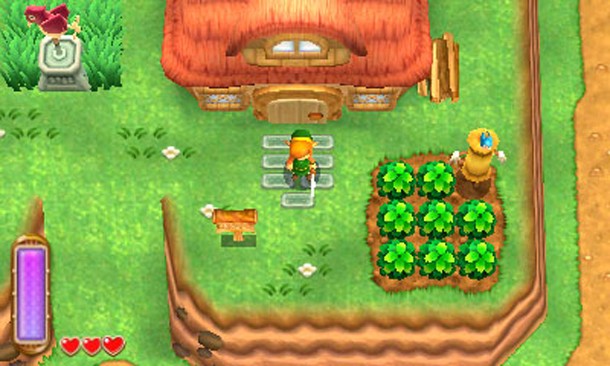Please support Game Informer. Print magazine subscriptions are less than $2 per issue
The Legend of Zelda: A Link Between Worlds Review

When Nintendo announced that it was returning to A Link to the Past’s version of Hyrule for A Link Between Worlds, I expected a nice, nostalgic homage to the SNES classic. I didn’t think it would blow me away. I was wrong. This isn’t just a tribute; as amazing as A Link to the Past is, I can’t think of a single thing A Link Between Worlds doesn’t do better.
Series traditions are back and better than ever, but I was surprised at Nintendo’s willingness to shake up formulas that have been in place for years. Early in the game, a rabbit-like creature called Ravio invades Link’s home and sets up a shop inside. There, Link pays a small fee to rent any item he wishes, including series standbys like the bow, boomerang, hammer, and hookshot. These items operate on a regenerating meter, so the days of harvesting arrows and bombs are over. While A Link to the Past featured cool items like the fire rod, I rarely used them because they depleted my magic meter. With the regeneration, you’re now free to use any item as much as you want.
If you’ve rented any items, Ravio takes them all back when you die. Later on, you’re given the option to permanently purchase these items for a higher price. This system breaks from tradition in a major way, as Link’s item screen can be loaded up early on. Some Zelda purists may cry foul at such a major shift in formula, but I loved it. After spending hundreds of rupees to rent items, it becomes genuinely scary when you’re about to fall in battle. Considering that most items are available at any time, I was impressed that the various heart pieces and collectibles still require plenty of thought to obtain.
Items aren’t the only part of the old formula that’s been changed. Maps are a thing of the past, as the dungeon layouts are visible from the moment you step in the front door. If you’re afraid that this dumbs down the experience or makes it simpler, don’t be. These numerous dungeons are filled with devious traps and incredibly clever puzzles, many of which make great use of the mechanic that allows Link to turn into a 2D drawing and walk along walls. I’d stare at a puzzle and deem it impossible to solve, only to remember Link’s new ability and use it to find an alternate path through an area. Unlike a specific item or weapon being used in obvious places (shooting an eye switch with an arrow, for example), this is an ability that forces you to look at things differently throughout the entire game.
Dungeons are so well-designed that even a dreaded water temple is a ton of fun to play through. As if some of the best dungeons in Zelda history weren’t enough, they typically end with some of the best bosses Link has ever encountered. Since the special items are always available and are no longer regulated by a finite meter, you are free to experiment with different methods of attack. Some of these baddies are returning foes from A Link to the Past, but many are brand new. To top off the experience, the quest ends with a suitably challenging and unique final boss fight.
In another break from tradition, players are given more choice when it comes to what order they want to tackle the dungeons in. No number system is in place to tell you where to go next, and no characters try to push you in any particular direction. It’s freeing to simply wander the map and explore new areas and dungeons at your leisure. When one boss was giving me a particularly hard time, I was able to leave, gain some more heart containers by defeating other dungeons, and then return stronger to defeat it.
The connection to the past is always obvious, from the fantastic new versions of classic tunes to the returning sound effects. Even though Hyrule is laid out in the same general manner as A Link to the Past, Link Between Worlds is not just a copy-paste job. Smart tweaks have been made to aid exploration. Fast travel opens up early on, and occasional caves or breaks in treelines make it easier to reach areas that previously required more legwork.
Zelda may be one of my favorite series, but I admit its faults when they’re present. However, I wouldn’t change anything about this game. The new item system is a welcome change of pace. The lifted restrictions on dungeon order offers a great sense of freedom. The dungeons and boss battles are all excellent. The presentation is stellar, with gorgeous, vivid visuals, and one of the best soundtracks in gaming. I want to let the experience roll around in my brain for a while before I decide where it ranks among the best entries in the franchise, but I can say with confidence that it should be spoken in the same breath as A Link to the Past. In every way, A Link Between Worlds is exactly what you want out of a Zelda game.




















